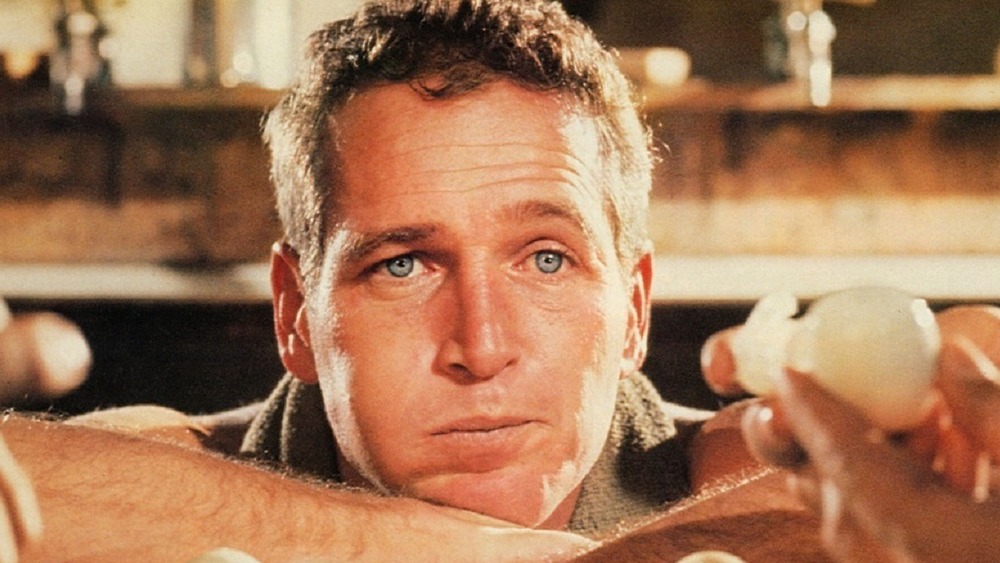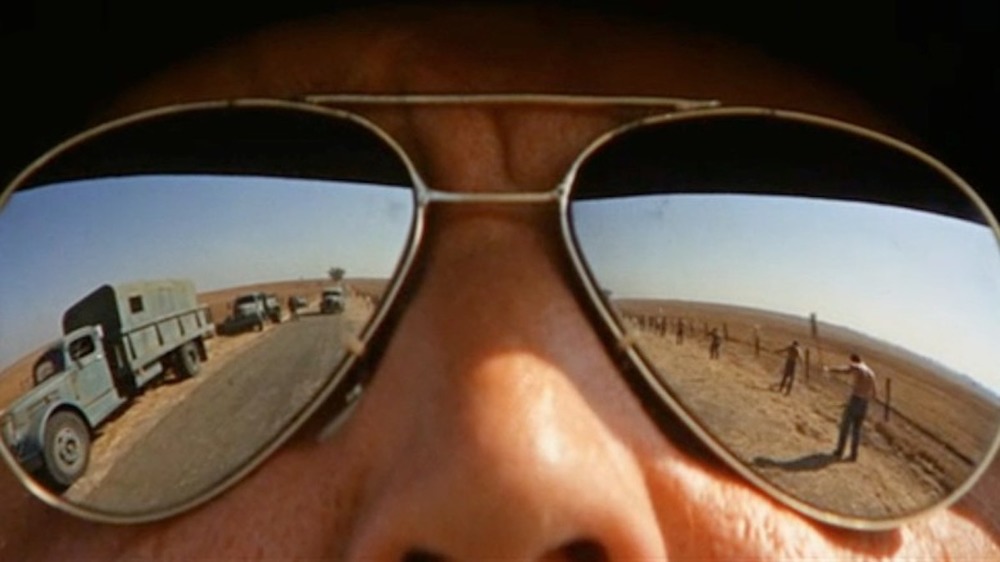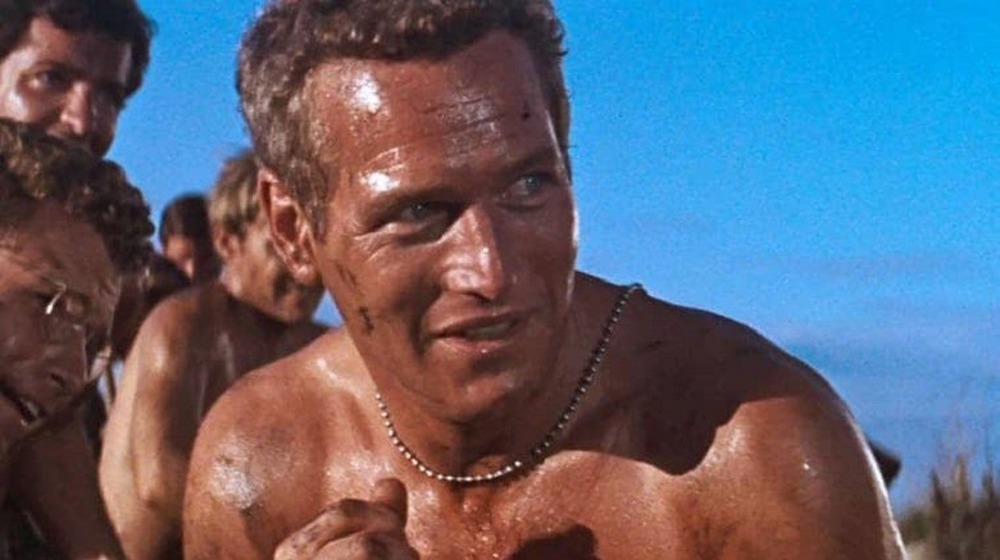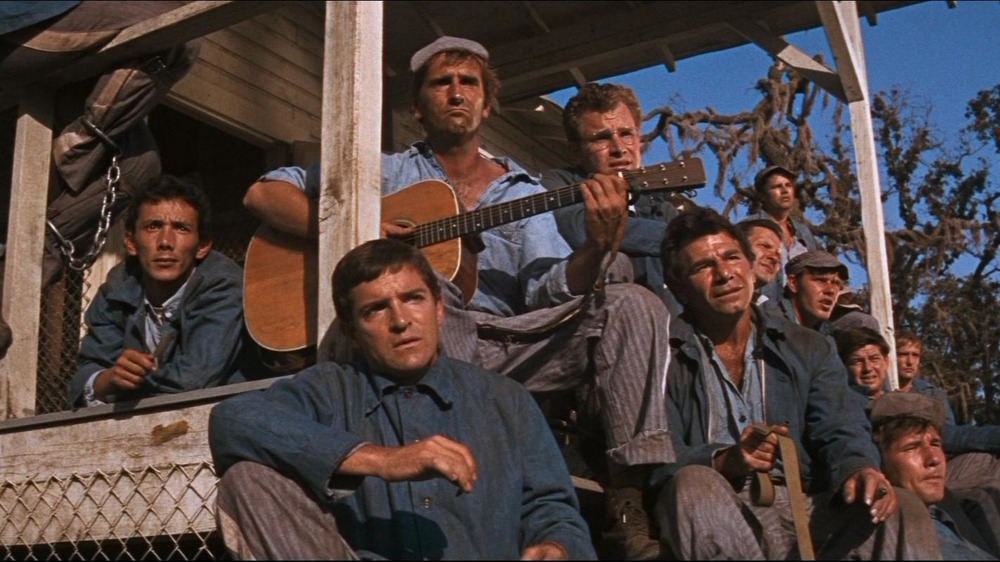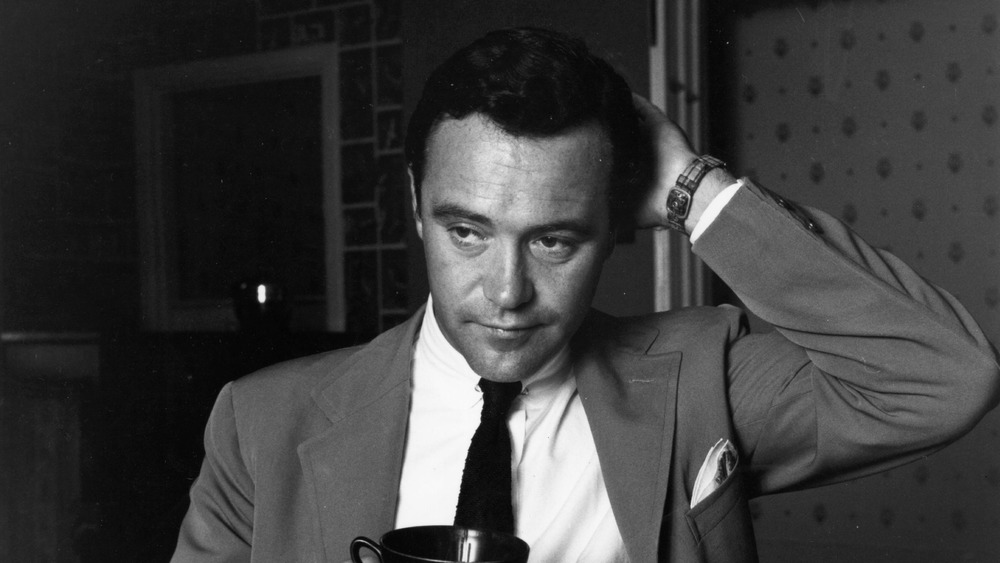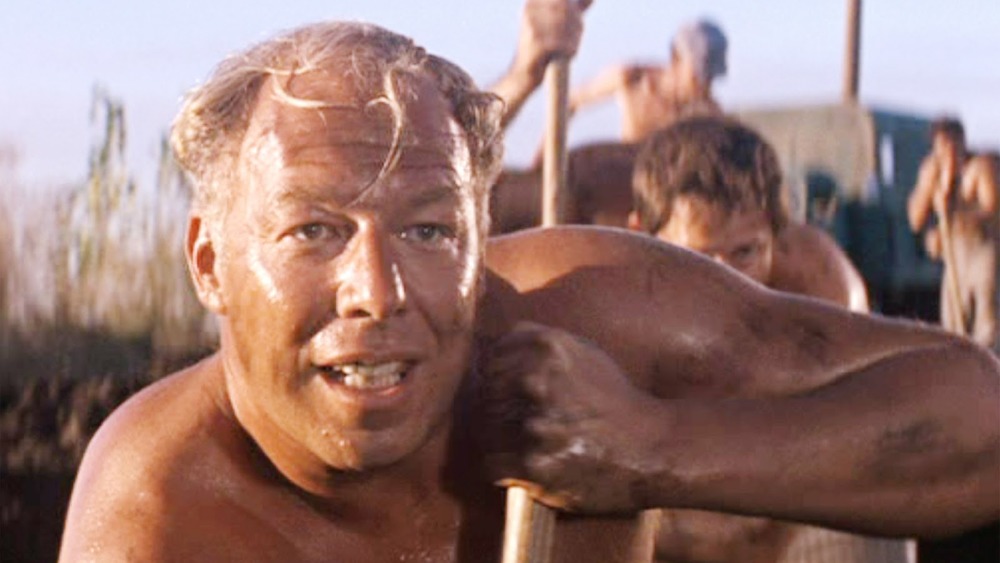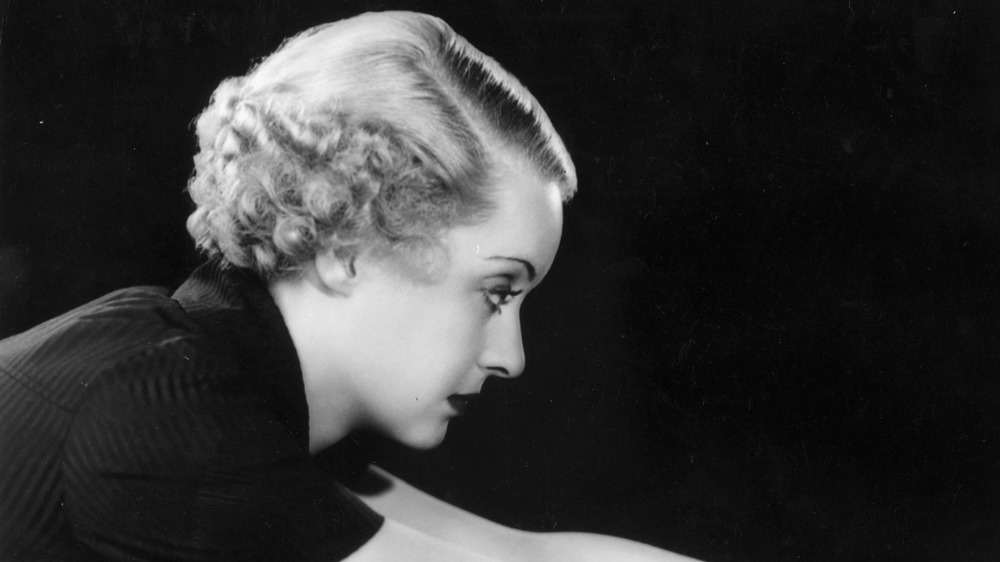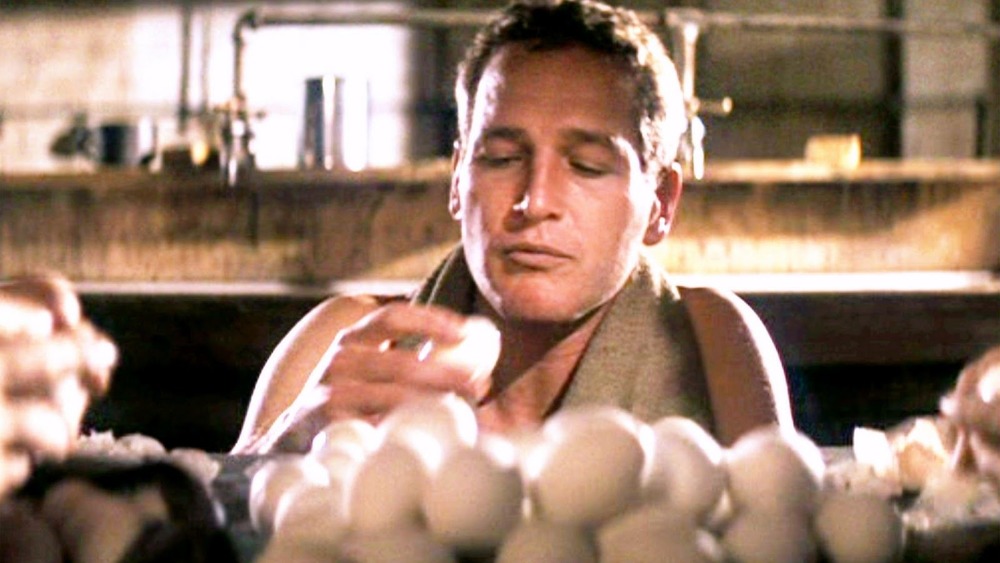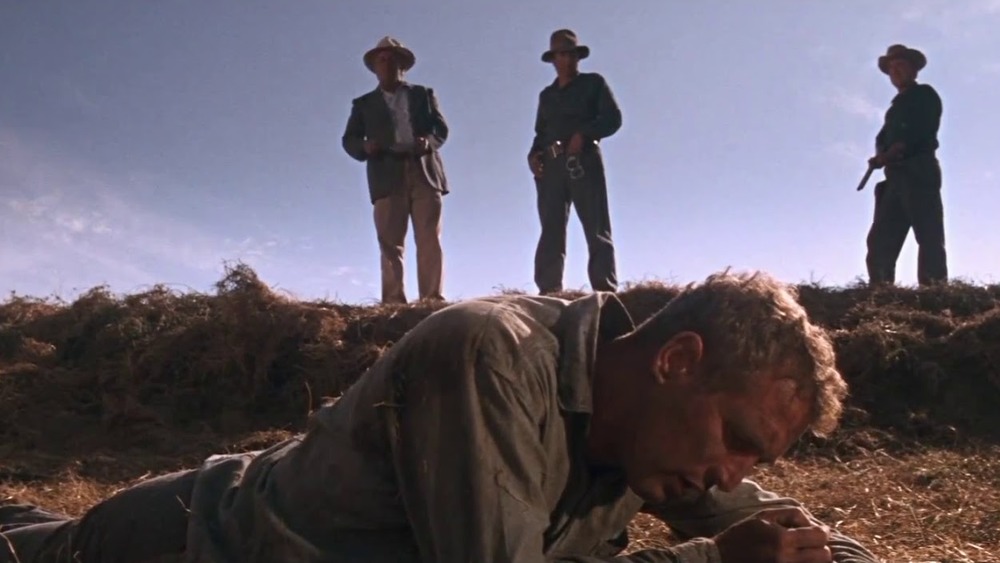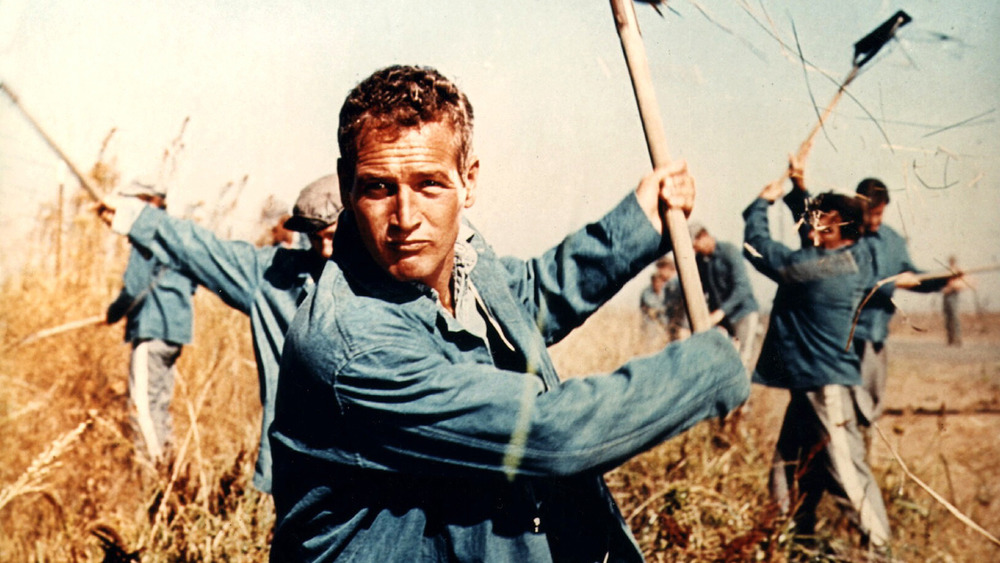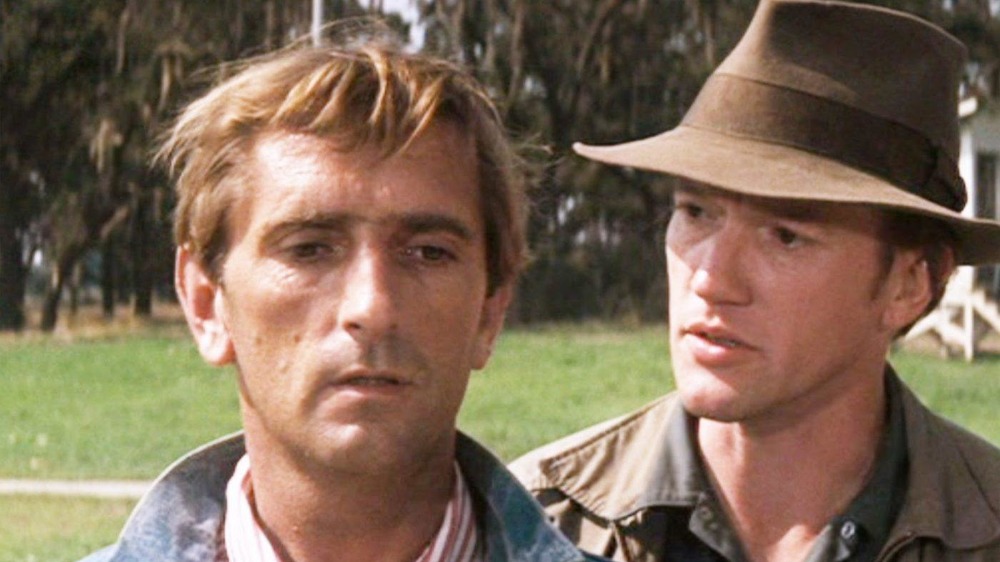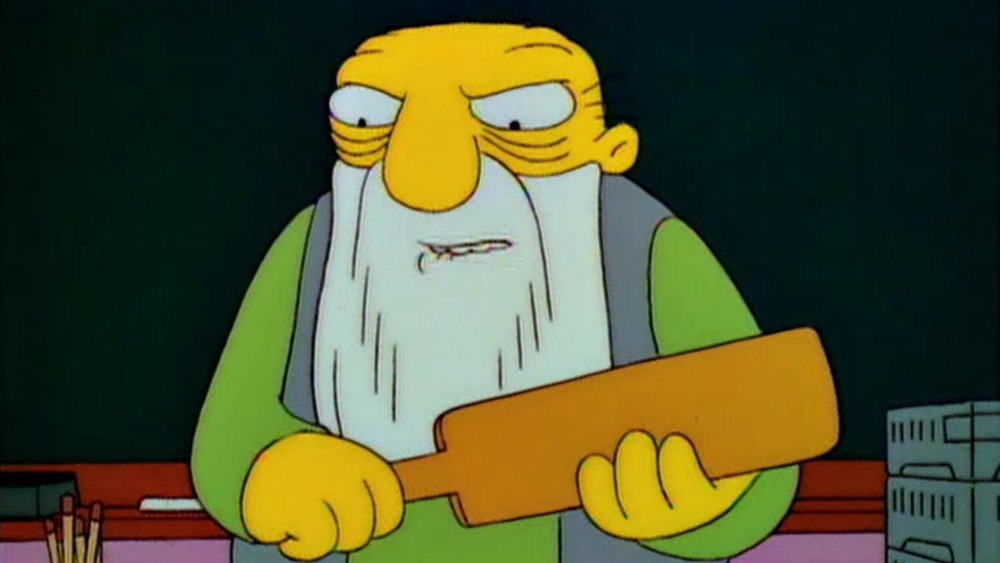The Untold Truth Of Cool Hand Luke
In 1967, TV director Stuart Rosenberg teamed up with writers Donn Pearce and Frank Pierson to tell the story of Lucas Jackson, a man condemned to a sweaty Southern prison camp for a petty crime. He earns the admiration of the other prisoners for his escape attempts and his absolute refusal to follow orders. However, Cool Hand Luke is far more than a simple escape story. In fact, this cinematic classic is a lot of things at once.
For example, it's an acting showcase for its star, Paul Newman, maybe the best he ever got. It's a timeless narrative of the individual's struggle against heartless authority, and it's a very timely tale about how that struggle played out in the '60s. It's a mythic, universal story, and it's one filled with gritty specificity. It's a story about a Christ figure, or maybe it's about a mortal man wrestling with God. Whatever else it is, it's a thrilling film, and there are plenty more thrilling stories in the history of bringing it to the screen. Here are just a few of them.
(This article contains spoilers.)
Cool Hand Luke's author had an exciting life
Cool Hand Luke was based on the novel by Donn Pearce, but Luke's adventures look downright tame next to his creator's. When he was only 18, Pearce joined the US Merchant Marines in the aftermath of World War II, before he fell in love with a pregnant Italian reporter and went AWOL. From there, he drifted his way across Europe, cracking safes, counterfeiting money, and escaping prison. But back home, his life of crime finally caught up with him, and he spent a year on the chain gang in Florida. That must've scared him straight because he switched careers to writing.
The idea for Cool Hand Luke struck him when he heard "The Battle of New Orleans," a song about the 1815 battle between British soldiers and Andrew Jackson's army. "That was Luke," Pearce told the Sun-Sentinel, 'like the British in the song, he kept on a-running, and no one could catch him." That spark soon turned into a novel, and from there, into a movie, but Pearce didn't fit in well with the Hollywood crowd. In Paul Newman: A Life, Shawn Levy writes Pearce even got in a fistfight on the set. The adaptation was a blockbuster, but that didn't translate to prestige for Pearce, who struggled to find work as a writer. So he switched careers one more time and spent most of his life working as a bounty hunter, though he insisted on being called a "skip man."
There may be a real Cool Hand Luke
In addition to "The Battle of New Orleans," it's possible that writer Donn Pearce found inspiration in an actual convict. Now, it may be hard to believe a larger-than-life character like Luke Jackson came from real life, but Donald Graham Garrison's story had already reached tall-tale status before it ever reached the screen.
Garrison — who preferred to be called Luke because he thought it sounded manlier — spent nearly 40 years in and out of prison, and he was frequently "out" against the Department of Corrections' wishes, escaping from both the Ohio State Penitentiary and a Southern chain gang. Garrison's adventures made him a legend among American prisoners, and some believe these tales eventually reached Donn Pearce's cell in Florida. In fairness, Pearce denied this to the Fort Lauderdale News, saying he was inspired by a prisoner who died on a Florida chain gang ... but not Garrison. Plus, Pearce claims that a lot of the story is based on his own life, saying he really did eat 50 eggs on a bet, which inspired one of Cool Hand Luke's most famous scenes.
However, Garrison stuck to his version of events, and he wasn't much of a fan of the film, either. He called Cool Hand Luke "incomplete" and said, "I want it done just like I lived it."
The set was a detailed recreation of a real Florida jail
Cool Hand Luke never nails down its setting to any place more specific than the American South, but director Stuart Rosenberg had Florida in mind for the location of his prison camp. In fact, he was inspired by a specific, very real jail in the small town of Tavares, where Donn Pearce had been imprisoned. The crew even shipped Spanish moss from Florida to hang up in the trees for the right Southern flavor.
George Kennedy, who won an Oscar for his role as Dragline, described the transplantation of the Florida prison to California in his memoir, Trust Me. "The original in Florida was old, the sideboards warped, and the beams aged. It was all duplicated exactly. If you didn't know otherwise, you would have bet hard cash it'd been there 50 years or more." The crew actually did manage to fool the state of California. Shawn Levy's Paul Newman: A Life describes a visit from the county sheriff who condemned the "residence."
It almost had a much less heart-throbby star
Paul Newman was already a star when he made Cool Hand Luke, but its success took him to another level as a sex symbol and icon of "angry young man attitude" — not bad for someone who was already over 40! It's one of the most acclaimed and beloved performances of the era ... but not with everyone. Donn Pearce said he was "too scrawny." He may have been happier with some of the other actors the producers eyed for the part.
According to Newman's biography, one of the producers, Jack Lemmon, considered taking the lead himself. Lemmon was one of the great comedic leading men in Hollywood, starring in classics like The Apartment and Some Like It Hot, and he would prove his dramatic chops in films like Glengarry Glen Ross. However, while Newman was sexy and glamorous, Lemmon was the ultimate everyman, and Cool Hand Luke would've been very different with him in the lead.
You could say the same about one of the other options considered for the part, Telly Savalas, who was about three years older than Newman (and even more years older than Newman looked). The bald, portly star is best known as the star of the detective show Kojak and James Bond's nemesis, Blofeld, in On Her Majesty's Secret Service. In other words, he's not much like Newman, but whatever inspired the producers to make such a total about-face on their vision for the character, it paid off.
Paul Newman toured the South to create Luke
Like many actors of his generation, Paul Newman studied at the Actors' Studio, which taught that it was essential to fully understand a character before you start to play them. So Newman prepared for his role by touring around the South to study the dialect and mannerisms he'd need to convincingly transform himself from an Ohio Yankee into a good old Southern boy. Newman contacted Peace Corps founder Sargent Shriver, who he knew through his activism with the Democratic Party, to find a guide through West Virginia. Shriver got Newman in touch with a businessman in Huntington named Andy Houvouras in the town of Huntington.
In a special report for West Virginia Public Broadcasting, Houvoras' family and other Huntington residents recalled Newman's time scouting the state. They described Newman's itinerary, which was mostly taken up with just getting to know people — from his fellow actors in regional theater to the area's most impoverished citizens — to get a sense of what Luke and his life might be like. All that time paid off with one of the greatest performances of the era, by Newman or anyone else.
The sweatiest scene was filmed in shivery weather
If there's one word to describe Cool Hand Luke, it's "sweaty," with the scenes of half-naked prisoners laboring in the hot Southern sun making the heat and exhaustion so palpable that perspiration almost drips off the screen. And one iconic scene is sweaty in another way, as it's focused on the men's impotent sexual desire.
After Luke goes to work digging a ditch on the chain gang, he watches as the other prisoners all but drool over a woman in a tiny dress washing a car nearby. Dragline imagines a whole story for her and makes up a name because "anything so innocent and built like that just gotta be named Lucille."
Actress Joy Harmon really was pretty innocent when she filmed the scene. She told Entertainment Weekly, "My concept of the [scene] was not like what came out. I was not aware that there were two meanings to things that I was doing, and I'm still not really that much aware of what they all were."
But thanks to movie magic, the woman and the prisoners were never actually in the same place at the same time — or even the same season. Kennedy said that by the time the men filmed their side of the scene, winter was setting in, and Harmon's stand-in had to wear a heavy overcoat. But you'd never know it watching the prisoners bake in the imaginary sun in the finished movie. As Kennedy says, "Those guys shivering in a ditch did some great acting."
Bette Davis was the first choice for Luke's mother
One of the best performances in Cool Hand Luke is also the briefest, when Jo Van Fleet appears as Luke's mother, Arletta, visiting him to say goodbye because she's on death's door. She can't even walk. Instead, she lies in a sickbed under a mosquito net in the back of a pickup truck. Van Fleet is such a powerful presence that when we learn Arletta has died, we feel Luke's grief even though we've only known her for a few minutes.
Van Fleet had already established herself in both movies and theater, including another classic role as a conflicted mother to James Dean in East of Eden. But the role of Arletta almost went to a genuine movie star. In his biography of supporting player Harry Dean Stanton, Hollywood's Zen Rebel, Joseph B. Atkins mentions that the producers' first choice for Arletta was Bette Davis.
Davis was one of the defining performers of multiple eras, an icon of dark, dangerous sexuality in classics like Jezebel and Now, Voyager. And she had staying power, earning an Oscar nomination for the ultimate backstage drama All About Eve and giving a bone-chilling performance in the title role of Whatever Happened to Baby Jane? a few years before Cool Hand Luke. It's hard to imagine even Davis improving on Van Fleet's performance, but she would've had one advantage — Van Fleet was only ten years older than her on-screen son!
Paul Newman claimed he swallowed none of those eggs
One of the many ways the prison breaks the inmates' spirits is by wearing them down with sheer tedium. But Luke manages to raise his bunkmates' spirits right back up, at least for a little while, with a circus-worthy stunt. One night, he offhandedly bets he can eat 50 eggs. When Dragline asks why, Luke just shrugs and says, "Something to do." As the whole prison crowds around him to watch, Luke eats all 50, even if he almost — literally — kills himself doing it.
Newman's performance is so convincing you might believe he really did eat 50 eggs, but he insisted the number is about 50 less than that, saying, "I never swallowed an egg." An interviewer once asked, "Isn't method acting about doing the real thing?" But Newman had a smart answer ready: "Not if you have to eat 50 eggs."
George Kennedy said the number was higher, but not by much. As he wrote, "There were garbage cans just out of camera range. My guess is that he consumed about eight or so because as soon as the director yelled 'cut,' he would relieve his mouth and throat of everything he could." But Kennedy also said, "There was a more serious problem. It would take two days to finish the egg sequence. ... On day two, the smell of day-old hard-boiled eggs permeated everything. Between shots, we all ran for the exits and didn't come back inside until we'd stuffed tissues up our nostrils."
The writer had to fight for the most famous line
If there's one thing everyone remembers from Cool Hand Luke, it's a specific line: "What we've got here is ... failure to communicate!" It's spoken by Strother Martin as the warden, or "Captain," after he beats Luke up for "back-sassing" him. That scene's been quoted more than any other in the movie, and it's seeped so completely into popular culture that you might hear it from people who couldn't even tell you what Cool Hand Luke is about. But it just barely made it to the screen at all.
"The phrase just sort of appeared on the page," screenwriter Frank Pierson said, adding, "Then I thought, these words are going to be spoken by an actor who is playing a real redneck character who probably never went beyond high school, and it has a faintly academic feel to it, that line. I thought, people are going to question it."
But it was too good to cut, and Pierson came up with a backstory for the Captain to justify it, envisioning him as a former guard who took college-level criminology classes to get a leg up in the hierarchy. Even after justifying the dialogue, Pierson still had to fight for it, as Donn Pearce agreed that it was too highfalutin for the Captain ... but not that it was good enough to keep. Fortunately, cooler heads won out, and that quote cemented Cool Hand Luke's place in film history.
There's a biblical allusion hidden on Luke's uniform
Cool Hand Luke opened to universal praise, but many critics agreed it had one flaw — the movie laid it on a little thick with the obvious Christ symbolism, with Luke collapsing in a crucifixion pose after he eats his 50 eggs, asking God why He's forsaken him right before he dies, and so on. But far from being too obvious, there's one biblical allusion that's so subtle hardly anyone's picked up on it.
Like all the prisoners, Luke gets a number printed on his uniform. His is 37, and if you look up his namesake — the Gospel of Luke — chapter one, verse 37 says, "For with God nothing shall be impossible."
Whether it's a clever bit of hidden symbolism or just a coincidence, it's an appropriate reference for Newman's larger-than-life hero. In Cool Hand Luke, the prisoners have given up on life because they believe it's impossible to overcome the prison's authority. Luke proves them wrong by escaping three times. He seems to do some things, like eating all those eggs or continuing to fight Dragline long after he's beaten, just to prove they're possible. And even if the Captain does catch up with him in the end, Luke's still made an impact on the rest of the prison by proving freedom isn't as impossible as they thought.
There's an early appearance in Cool Hand Luke by an acting legend
Besides Luke and Dragline, Cool Hand Luke is filled with a whole cast of prisoners with colorful names. If you look closely, you may recognize some of them. Dennis Hopper, who plays Babalugats, would become a counterculture icon a few years later with Easy Rider.
And in an even more minor role, you'll see Harry Dean Stanton, an actor so great he inspired Roger Ebert's Stanton-Walsh rule — "No movie featuring either Harry Dean Stanton or M. Emmet Walsh in a supporting role can be altogether bad." Even a brief look at the movies Stanton appears in proves that rule, with classics like Alien, Repo Man, The Godfather Part II, The Last Temptation of Christ, and a whole bunch of David Lynch movies. He's also had some great starring roles, most famously in the modern Western epic Paris, Texas. More recently, he had a memorable cameo appearance as a janitor in The Avengers, and he returned to Twin Peaks for The Return.
Stanton couldn't yet command those kinds of pivotal roles when he made Cool Hand Luke, but he still played one behind the scenes. One of the most powerful sequences shows Luke strumming "Plastic Jesus" on the guitar when he learns his mother's died, somehow turning a silly novelty song into a heartfelt lament. Stanton told Venice Magazine that Newman insisted on playing the guitar for real, and Stanton pitched in to teach him.
Cool Hand Luke's 'night in the box' scene had a long afterlife
Cool Hand Luke became a phenomenon on its release, and filmmakers have been drawing from it ever since. One scene in particular should be familiar even if you've never seen it. When Luke arrives in prison, he listens to a guard give a long lecture on all the rules, with the punishment for every one of them being, invariably, "a night in the Box" — a solitary confinement cell designed to trap the Southern heat.
The guard's speech should be familiar to Pixar fans from Toy Story 3, where Lotso, a teddy bear who runs the Sunnyside Daycare like a prison, reprograms Buzz Lightyear to turn him into his enforcer against the other toys. Buzz puts down his friends' escape attempt and runs down his own list of rules — but in this case, the "box" is a sandbox.
And if you're a Simpsons fan, you should recognize the Cool Hand Luke reference when Grandpa's friend, Jasper, takes over as a substitute teacher with some good old-fashioned corporal punishment. "Lookin' out the window? That's a paddlin'. Staring at my sandals? That's a paddlin'. Paddlin' the school canoe? Oh, you better believe that's a paddlin'." Cool Hand Luke is a must-see classic, and if you deny yourself the joy of watching it, you may just deserve a paddlin'.
